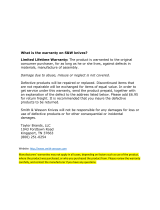
3
Table of Contents
Warranty and Service .............................................................................................................................. 2
Table of Contents .................................................................................................................................... 3
Warnings ................................................................................................................................................. 4
Specifications .......................................................................................................................................... 7
Features and Terminology ....................................................................................................................... 8
Receiving ................................................................................................................................................ 8
Unpacking ............................................................................................................................................... 8
Electrical Connection ............................................................................................................................... 8
Operating Controls .................................................................................................................................. 9
Jointer to Planer Setup ......................................................................................................................... 9
Planer to Jointer Setup ......................................................................................................................... 9
Power ................................................................................................................................................ 10
Planer Controls and Adjustments ....................................................................................................... 10
Jointer Controls and Adjustments ....................................................................................................... 10
Adjustments .......................................................................................................................................... 12
Table and Knife Adjustments .............................................................................................................. 12
Coplanar Alignment............................................................................................................................ 12
Setting Cutterhead Knives (Straight Knives Only) ............................................................................... 14
Replacing Cutter Knives (Straight Knives Only) .................................................................................. 15
Replacing or Rotating Knife Inserts (Helical Cutterhead only) ............................................................. 15
Jointer Table Lock Handle Adjustment ............................................................................................... 16
Belt Replacement ............................................................................................................................... 16
Planer Table Adjustment .................................................................................................................... 18
Basic Operations ................................................................................................................................... 19
Dust Collection ................................................................................................................................... 19
Initial Startup ...................................................................................................................................... 19
Changing Mode of Operation ............................................................................................................. 19
Jointer Operations .............................................................................................................................. 19
Planer Operations .............................................................................................................................. 21
Maintenance .......................................................................................................................................... 23
Blade Care ......................................................................................................................................... 23
Sharpening the Knives (Straight Knives Only) .................................................................................... 23
Lubrication............................................................................................................................................. 23
Troubleshooting ..................................................................................................................................... 24
Performance Troubleshooting – Jointer .............................................................................................. 24
Performance Troubleshooting – Planer .............................................................................................. 25
Mechanical Troubleshooting – Planer/Jointer ..................................................................................... 26
Parts List ............................................................................................................................................... 27
Assembly Drawings ............................................................................................................................... 32
Infeed Table Assembly ....................................................................................................................... 32
Outfeed Table Assembly .................................................................................................................... 33
Cutterblock Assembly ........................................................................................................................ 34
Base Assembly .................................................................................................................................. 35
Motor Assembly ................................................................................................................................. 36
Planer Table Assembly ...................................................................................................................... 37
Fence Assembly ................................................................................................................................ 38
Electrical Connection ............................................................................................................................. 39
Accessories ........................................................................................................................................... 39
Ordering Replacement Parts.................................................................................................................. 40
The specifications in this manual are given as general information and are not binding. Walter Meier
(Manufacturing), Inc. reserves the right to effect, at any time and without prior notice, changes or
alterations to parts, fittings, and accessory equipment deemed necessary for any reason whatsoever.




















